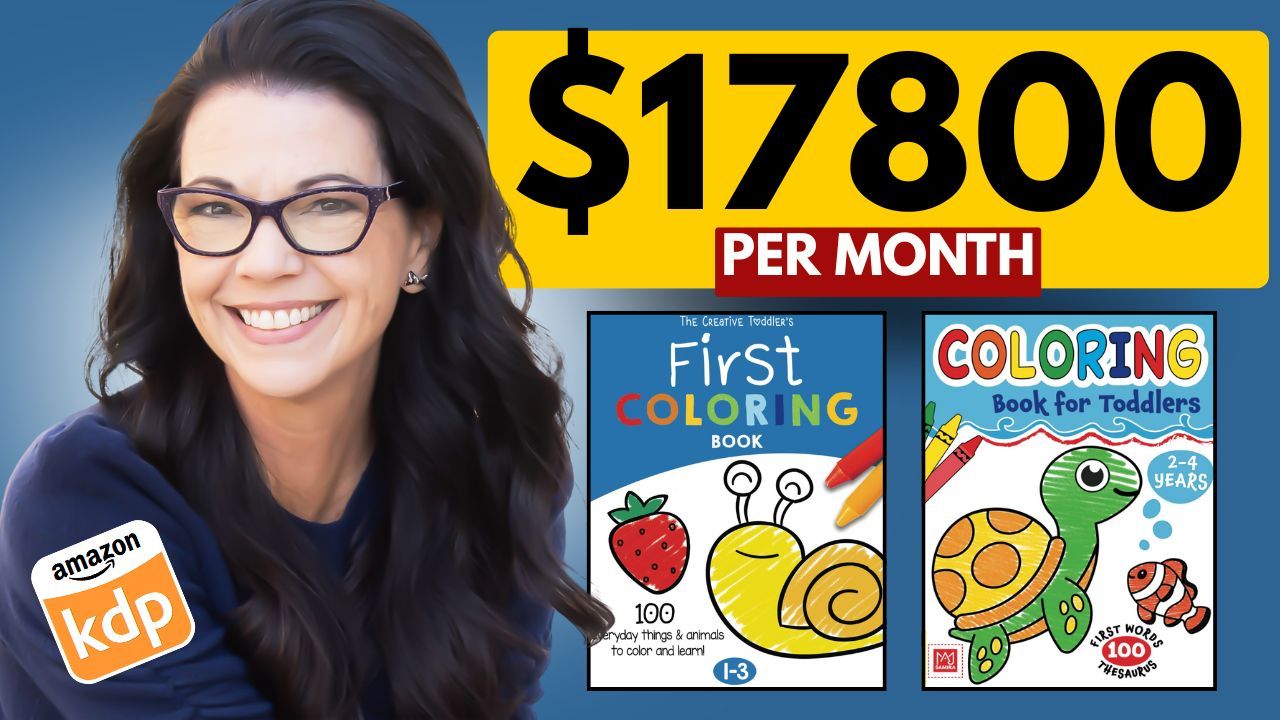How to Create a Best-Selling Children’s Coloring Book for Amazon KDP (My Complete Step-by-Step Process)
Nov 18, 2025
Creating a children’s coloring book for Amazon KDP can feel overwhelming—especially when it comes to choosing which tools, apps, and subscriptions you actually need. Do you have to pay for anything? When should you upgrade? When is “free” good enough?
In this guide, I’ll walk you through my exact process for researching, designing, and publishing a profitable kids’ coloring book—while also breaking down which tools I personally pay for, which ones I skip, and how I choose between them.
And if you want this entire tutorial written out step-by-step, it’s also available on my website at reneeclancy.com.
Step 1: Start With Market Research on Amazon
I always begin directly on Amazon. I type in “kids coloring books” and scroll through the top results to see:
-
What styles are trending
-
What themes keep reappearing
-
Which books have strong reviews
-
Which designs are realistic for self-publishers to create
You’ll usually run into big brands (Disney, Coco Wyo, etc.), but don’t worry—your goal is to look for styles and ideas you can create.
Once I get a sense of what’s popular, I move to the data.
Step 2: Use KDP Spy (or Any Plugin You Prefer) to Evaluate Profitability
This is the first paid tool I use: KDP Spy, included with a Book Bolt subscription.
Book Bolt starts at $9.99 per month, and the plugin shows you:
-
Estimated monthly revenue
-
Estimated sales
-
Book age
-
Keyword strength
There are alternatives like Publisher Rocket, but I haven’t found a free plugin that gives accurate profit estimates. If you know one, please tell me—I’d love to try it.
I sort by estimated revenue to see which coloring books earn the most. That’s how I found a “My First Coloring Book” style title making around $17,000/month and still selling strong years after release.
That’s your confirmation: simple, bold toddler coloring books are still hot.
Step 3: Analyze the Bestsellers Before Designing
Before I create anything, I click through the book and study:
Front Cover
-
Bright colors
-
Kid-colored look
-
Simple shapes
-
Clear title
Interior
-
Bold outlines
-
No grayscale
-
Words are hollow text (easy to color)
-
Large, simple line art
-
100 total images printed on both sides
Reviews
This is where readers tell you exactly what to replicate.
Common praises:
-
Simple artwork
-
Thick lines
-
Words toddlers can color in
-
Familiar household objects
Common complaints:
-
Paper is thin (but this is normal for kids’ books)
All this tells me exactly what style I need to recreate.
Step 4: Set Up Your Canva Template
I use Canva Pro (yearly subscription—worth it for me because I use it daily).
My template includes:
-
8.5 x 11 size
-
102 pages (title page, copyright page, plus 100 interior pages)
-
Pre-placed word text for consistency
-
Ready-to-fill layout so I don’t recreate the wheel each time
I simply duplicate this template for every new coloring book.
Step 5: Decide Where Your Images Will Come From
Here’s where subscription fatigue can hit fast.
Option 1: Canva’s Built-In AI
I can type:
“Simple coloring book page, black and white outline, no grayscale”
Canva does a decent job, but not always consistently.
Option 2: Canva’s Coloring Book App (Paid Add-On)
It generates great minimalist coloring pages.
Problem: it’s another $6.99/month.
I didn’t want another subscription, so I kept looking.
Option 3: Gemini AI
Gemini can produce images in bulk, but I found:
-
Sometimes it creates 5 at a time
-
Sometimes 2
-
Sometimes the same image over and over
-
Sometimes it repeats previous images
-
Sometimes it adds unwanted text
I pay for Gemini Pro (for my 9-to-5 job), but if I didn’t already have access, I wouldn’t subscribe just for coloring books.
Option 4: Canva Clip Art
This actually ended up being my main workflow.
You cannot sell a single clip-art element by itself, but you can use clip art as part of a larger design inside a coloring book.
With over 85 images needed, Canva’s clip-art library saved me hours.
Step 6: Make the Designs Consistent
In Canva’s Grid View, I checked:
-
Line thickness
-
Style consistency
-
Simplicity
-
Repeated elements
-
Word placement
If one image had thick lines and another had very thin lines, I went back and replaced it. Consistency matters in kids' books.
Step 7: Export Your Manuscript as a PDF
Export as:
-
PDF Standard for interiors
-
PDF Print (High Quality) for the cover
Make sure your pages use bleed just in case elements sit close to the edge.
Step 8: Create the Cover Using a Free KDP Template
Use the free Amazon KDP Cover Calculator to get the exact dimensions based on your page count.
I upload the KDP template into Canva, lower the transparency, and design on top of it.
My cover elements:
-
Solid blue background
-
Toddler-colored rainbow
-
Toddler-colored tree
-
Clouds
-
Bold title on a red rectangle
-
Matching interior typography
-
Back cover preview images
Everything matches the interior style.
Step 9: Upload to KDP
My choices:
-
Black & white interior
-
8.5 x 11 trim
-
Bleed
-
Glossy cover
-
PDF manuscript
-
High-resolution PDF cover
Keywords and Subtitle
ChatGPT generated these for me (based on SEO).
Example subtitle:
100 Simple Pictures and First Words for Toddlers to Color
Example long-tail keywords:
-
“toddler coloring book ages 1-3”
-
“simple first words coloring pages”
-
“bold line art for toddlers”
Step 10: Pricing
Most books in this niche sell for $6.99, so I matched the market—even though it lowers my royalty to around $0.66.
For kids’ books, competitiveness matters more than a high royalty.
Step 11: Publish!
Once everything looked correct in the KDP previewer, I approved it and published.
Final Thoughts on Subscription Costs
Here are the tools I currently pay for:
Yearly
-
Canva Pro
-
Gemini Pro
-
ChatGPT Plus
Monthly
-
Book Bolt
I recommend starting with only ONE paid AI tool (Gemini or ChatGPT) and Canva Free. You can always upgrade later.
If you’re new:
Start with Canva + one AI tool + Book Bolt (optional).
That’s enough to build a great book.

